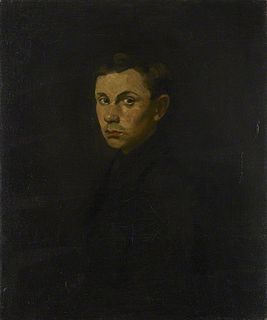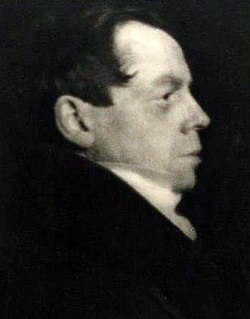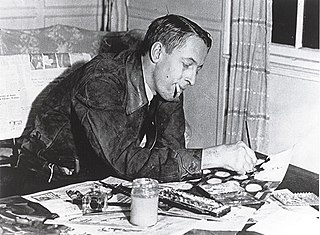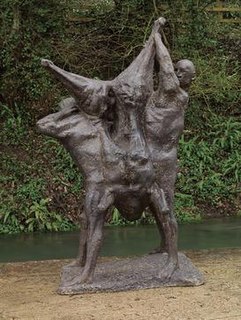Related Research Articles

Dame Jocelyn Barbara Hepworth was an English artist and sculptor. Her work exemplifies Modernism and in particular modern sculpture. Along with artists such as Ben Nicholson and Naum Gabo, Hepworth was a leading figure in the colony of artists who resided in St Ives during the Second World War.

Benjamin Lauder Nicholson, OM was an English painter of abstract compositions, landscape and still-life.

Sir William Newzam Prior Nicholson was a British painter of still-life, landscape and portraits. He also worked as a printmaker in techniques including woodcut, wood-engraving and lithography, as an illustrator, as an author of children's books and as a designer for the theatre.
Conroy Maddox was an English surrealist painter, collagist, writer and lecturer; and a key figure in the Birmingham Surrealist movement.

John Christopher "Kit" Wood was an English painter born in Knowsley, near Liverpool.

Jessica Stewart Dismorr was an English painter and illustrator. Dismorr participated in almost all of the avant-garde groups active in London between 1912 and 1937 and was one of the few English painters of the 1930s to work in a completely abstract manner. She was one of only two women members of the Vorticist movement and also exhibited with the Allied Artists Association, the Seven and Five Society and the London Group. She was the only female contributor to Group X and displayed abstract works at the 1937 Artists' International Association exhibition. Poems and illustrations by Dismorr appeared in several avant-garde publications including Blast, Rhythm and an edition of Axis.

Rosa Winifred Nicholson was a British painter. She was married to the painter Ben Nicholson, and was thus the daughter-in-law of the painter William Nicholson and his wife, the painter Mabel Pryde. She was the mother of the painter Kate Nicholson.
George Peter Lanyon was a Cornish painter of landscapes leaning heavily towards abstraction. Lanyon was one of the most important artists to emerge in post-war Britain. Despite his early death at the age of forty-six he achieved a body of work that is amongst the most original and important reappraisals of modernism in painting to be found anywhere. Combining abstract values with radical ideas about landscape and the figure, Lanyon navigated a course from Constructivism through Abstract Expressionism to a style close to Pop. He also made constructions, pottery and collage.

Sir Alan Bowness CBE was a British art historian, art critic, and museum director. He was the director of the Tate Gallery between 1980 and 1988.
Ivon Hitchens was an English painter who started exhibiting during the 1920s. He became part of the 'London Group' of artists and exhibited with them during the 1930s. His house was bombed in 1940 during World War II, at which point he moved to a caravan on a patch of woodland near Petworth in West Sussex. He worked there for the next forty years, gradually augmenting his caravan with a series of buildings. He is particularly well known for panoramic landscape paintings created from blocks of colour. There is a huge mural by him in the main hall of Cecil Sharp House. His work was exhibited in the British Pavilion at the Venice Biennale in 1956.

Edward John Burra was an English painter, draughtsman, and printmaker, best known for his depictions of the urban underworld, black culture and the Harlem scene of the 1930s.
Unit One was a British grouping of Modernist artists founded by Paul Nash. The group included painters, sculptors and architects, and was active from 1933 to 1935. It held one exhibition, which began at the Mayor Gallery in Cork Street, London, and then went on an extended tour, closing in Belfast in 1935. The artists planned the group at meetings held at the Mayor Gallery; Paul Nash announced its creation in a letter to The Times on 12 June 1933. A book by Herbert Read, Unit One: the modern movement in English painting, sculpture, and architecture, was published at the time of the exhibition. Despite its brief period of activity, the group is regarded as influential in establishing the pre-eminence of London as a centre of modernist and abstract art and architecture in the mid-1930s.
Gimpel Fils is a London art gallery previously located at 30 Davies Street in Westminster just off Grosvenor Square and has since moved. The gallery was founded by Charles and Peter Gimpel, sons of the celebrated Parisian art dealer, René Gimpel, author of the Diary of an Art Dealer. Throughout its history it has maintained a commitment to contemporary British and International art.

The Hepworth Wakefield is an art museum in Wakefield, West Yorkshire, England, which opened on 21 May 2011. The gallery is situated on the south side of the River Calder and takes its name from artist and sculptor Barbara Hepworth who was born and educated in the city. It is the successor of the municipal art collection, founded in 1923 as Wakefield Art Gallery, which spans the Old Masters to the twentieth century.
John Cecil Stephenson was a British abstract artist and pioneer of Modernism.
Three Forms is an abstract sculpture by Barbara Hepworth, completed in 1935.

Ralph Brown was an English sculptor who came to national prominence in the late 1950s with his large-scale bronze Meat Porters, commissioned for Harlow New Town, Essex and is known for his sensual, figurative sculptures.
Objective abstraction was a British art movement c. 1933–1936.
John Hitchens is an English painter. His work is influenced by the landscape of the South Downs and his main subject area is the countryside of West Sussex, England. He also spent extended periods working in North Wales and North West Scotland. Hitchens' paintings are primarily concerned with expressing patterns and textures of the landscape. During the past decades his work has evolved into an abstract style using a range of earth colours.
Four-Piece Composition: Reclining Figure (LH154) is an important early stone sculpture by the English sculptor Henry Moore. He had been working on depictions of the reclining human figure since at least 1924, but this small piece, made in the latter half of 1934, is the first work in which Moore breaks a human figure down in to several separate pieces. It was acquired by the Tate Gallery in 1976.
References
- ↑ "Seven and Five Society", tate.org.uk. Retrieved 24 February 2021.
- ↑ Causey 2008.
- ↑ "Business papers of the 7 & 5 Society". archiveshub.ac.uk. Retrieved 13 September 2016.
- ↑ "7&5. The Seven and Five Society the Fine Art Society - PDF Free Download".